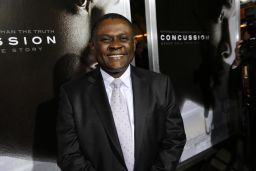The pioneering pathologist who discovered chronic traumatic encephalopathy (CTE) in NFL players spoke slowly and deliberately Friday about his autopsy on a young man whose death at the hands of police led to protests in California’s capital.
“At the second autopsy there were a total of eight gunshots – a total of eight gunshot wounds, meaning that he was hit by eight bullets,” Dr. Bennet Omalu said in the lilt of his native Nigeria.
“Stephon Clark received eight bullets. Six of the bullets … exhibited gunshot wounds of entrance in the back, meaning he was shot in the back six times.”
Omalu is no stranger to controversy: The NFL, a $13 billion industry, tried and failed to discredit his work.

The story of his struggle to reveal the dangers of a game he says he did not, himself, quite understand, was told in the 2015 movie, “Concussion.”
“Dr. Omalu is an immigrant, and a big part of why he fought so hard to have this information come out is because he believes in America and American ideals,” actor Will Smith, who played Omalu, told CNN in 2016.
Omalu discovered traces of the disease in the brain of legendary Pittsburgh Steelers player Mike Webster in 2002.
The Hall of Fame center known as “Iron Mike” was an anchor on four Super Bowl-winning teams before succumbing to substance abuse and becoming homeless. He died at age 50, and Omalu was assigned to perform his autopsy.
“Not a single paper had been published describing what I had observed in Webster’s brain,” he wrote in a 2015 commentary for CNN.
“None whatsoever. I honestly could not, and did not, believe it. It was simply impossible. Yes, much had been published on boxers,” he said, referring to the “punch drunk” condition known as dementia pugilistica, “but nothing had been written on any American football player.”
CTE is a progressive, degenerative disease set off by repeated head trauma. It has been detected in veterans, as well as players of other contact sports; however, it has become most associated with football.
In 2016, the National Football League publicly acknowledged a connection between football and CTE for the first time. That year, Commissioner Roger Goodell announced an initiative intended to increase the safety of the game, specifically by preventing, diagnosing and treating head injuries.
The NFL’s commitment to player safety has been in the spotlight since Omalu’s identification of CTE during Webster’s autopsy.
This week, Omalu performed an independent autopsy on Stephon Clark, who was shot multiple times by Sacramento police in his grandmother’s yard. The officers said they believed he was pointing a gun at them, police said. Investigators only found a cell phone near his body.
“You could reasonably conclude that he received seven gunshot wounds from his back,” Omalu told reporters Friday. Each of those bullets possessed “a fatal capacity,” he added.
“Meaning that, out of all the seven, all he needed to have died was just one of the seven.”
He announced the second autopsy results at a time when the public outcry over Clark’s death – which prompted several days of demonstrations at Sacramento City Hall and outside NBA games – continues to mount.
The initial autopsy conducted by the Sacramento County Coroner earlier this week determined the cause of death as multiple gunshot wounds, and the manner of death as homicide, according to a preliminary report. Authorities have not released the full report.
Police had previously said officers fired 20 shots at Clark on the evening of March 18, when they responded to a 911 call about a man who was breaking car windows.
Attorney Benjamin Crump, representing the Clark family, said he expects officials will try to “dispute” Omalu’s findings, like some researchers and NFL doctors attempted to do with his CTE research.





